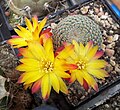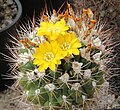|
Weingartia
Weingartia is a genus in the family Cactaceae, with species native to Bolivia and Argentina. It was formerly included in Rebutia, but molecular phylogenetic evidence suggested that it was distinct from that genus. As of December 2024[update], it was treated as separate genus by Plants of the World Online,[1] and recognized as an alternative generic name in the third edition of the CITES Cactaceae Checklist. It may also be treated as Rebutia subg. Weingartia.[2] Description Plants usually solitary. Stems globose to oblong, to 20 cm high and 15 cm, rarely 30 cm in diameter, fresh green. Ribs 12 – 18, spiraling, forming distinct tubercles. Areoles on the tubercle in excentric position, sunken in its higher part. Spines more robust and thick, 7 – 35 in one areole, radial spines 1 – 3 cm long, central spines 3 – 4, to 5 cm long. Flowers borne near the stem tips, one areole can produce up to 3 flowers, golden yellow to orange to reddish yellow, 1 – 3 cm in diameter.[3] Floral tube scales broad and imbricated. Fruits globose to ovoid, brownish. Seeds oblong, 1 mm long, black or brown.[citation needed] TaxonomyThe genus Weingartia was designated in 1937 by Werdermann to replace the invalid genus Spegazzinia Backeberg. All species of the genus Weingartia were transferred to the genus Rebutia by the International Cactaceae Systematics Group (ICSG) of the International Organization for Succulent Plant Study. A study in 2007 indicated that the genus Rebutia as then defined was polyphyletic. Sulcorebutia and Weingartia were kept as separate genera in the study; a summary cladogram for those species studied is shown below.[4]
Species formerly classified as Weingartia, Sulcorebutia and Cintia show a close relationship to each other.[4][5] As of December 2024[update], Sulcorebutia and Cintia are included in Weingartia by Plants of the World Online.[1] SpeciesAs of December 2024[update], the following species were accepted by Plants of the World Online]:[1]
DistributionAndes mountains of central and south Bolivia and northwest Argentina at elevations of 1600 – 3600 m.[citation needed] ReferencesWikimedia Commons has media related to Weingartia.
Literature
|
|||||||||||||||||||||||||||||||||||||||||||||||||||||||||||||||||||||||||||||||||||||||||||||||||||||||||||||||||||||||||||||||||||||||||||||||||||||||||||||||||||||||||
Portal di Ensiklopedia Dunia



















